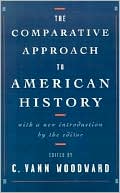

 |

|

The average rating for The Comparative Approach to American History based on 2 reviews is 4.5 stars.
Review # 1 was written on 2021-01-13 00:00:00 Christopher Nurding Christopher NurdingI've been a bit obsessed with communal Utopias this summer and this book gave a wonderful overview of all the weirdness, genius and madness that goes into living a counter culture lifestyle. I'll never look at my silverware the same again! |
Review # 2 was written on 2021-02-05 00:00:00 Douglas Lang Douglas LangChudacoff's work is a comprehensive analysis of the culture of children's play in the United States from the days of the Puritans up until the present. He neatly presents his analysis in terms of the interplay of four "contexts" that have affected play culture through the centuries: environment (urban, rural, indoors/outdoors), material culture (toys and children's literature, including comic books), peer interaction (who children play with, solitary play, playing "online" with friends) and the degree of freedom from adult intervention. The book is broken up into chapters based on dates: pre-1800, 1800-1850, 1850-1900, 1900-1950 and 1950-present. Although the subdivision of the history of play culture into roughly 5-decade periods is in fact somewhat arbitrary (which Chudacoff readily admits, as evidenced by his own data), it is an effective way to divide up what would otherwise be a difficult-to-read work. The writing definitely leans towards the academic in style (loads of supporting quotes from primary sources and extensive endnotes), while also obviously aiming at a general audience in its presentation. But disregarding the chronology, the four "contexts" provide a very useful way to understand how children's play has changed through time (I have to wonder though: would this analysis derived as it is from American history hold shape in the context of another culture? I am sure there is plenty of anthropological works written on this topic. It'd have been nice if Chudacoff provided some reference to them, but not a big deal). Chudacoff tries to identify successive periods in the history of children's play characterized different levels of each "context". But after reading the whole book, I find it easier to think of this history as a general shift in the balance between the four "contexts" as they spiral around a central helix of competing parental controls and children's push-back, and where the timing of contextual shifts being less important than the overall impression of what that shift means for contemporary society. Disregarding children's play culture the Puritan period, which Chudacoff characterizes as severely controlled by adults (or at least they try to) and permeated by children's guilt over the supposed "sinfulness" of their uncontrollable desire to play at idle pursuits, my impression of the history of children's play in the US after reading this book is this: 1) beginning in the mid-20th Century, play has increasingly become equated with manufactured toys, i.e. most play is no longer purely imaginary role-playing incorporating found objects or "toys" made by the child him or herself, and that this is largely due to the efforts of toy marketers to increase sales by appealing directly to kids (with allowances, and busy parents guilt-tripped about not giving enough attention to their kids); 2) there has been a "shift toward formal rather than ad hoc play-sites", i.e. children don't "roam" the countrywide or the city street and alleyways anymore, but instead play in highly supervised environments (indoors, on playgrounds or at commercial enterprises like Chuck-E-Cheese) mostly because of adults' concern for their safety; 3) adults have always tried to direct children's play towards the useful purposes of socialization, education and/or exercise intended to benefit the child's health, safety and future prospects (personally, as a parent I have mostly tried to ensure that my kids' toys have some semblance of educational value); and 4) play directed by adults has always been less fun for children than doing what they aren't allowed to do, going where they aren't supposed to go and just breaking the rules to see what happens. Play culture has changed in significant ways over the centuries, and usually to the chagrin of parents and other adults, but I think we can always count on children's penchant for testing boundaries to show through, no matter how it is shaped by the "contexts" of environment, material culture, peer interaction and adult intervention. An important lesson this book may have for parents is that if you do want to guide how and with whom and what your child plays, try not to make it so obvious. |
CAN'T FIND WHAT YOU'RE LOOKING FOR? CLICK HERE!!!